本文内容整理自西安交通大学软件学院李晨老师的课件,仅供学习使用,请勿转载
文章目录
文章目录
本章思维导图
Key characteristics of memory systems
- Location: Internal, External, Offline
- Capacity: word length, number of words
- Unit of transfer: word, block
- Access method: sequential, direct, random, associative
- Performance: access time, access cycle, bandwidth
- Physical type: semiconductor, magnetic, optical, magneto-optical
- Physical characteristics: volatile/nonvolatile, erasable/nonerasable
- Organization: how to form bits to words
Classification based on location
- Internal motherboard, including inside CPU
- External motherboard
- offline
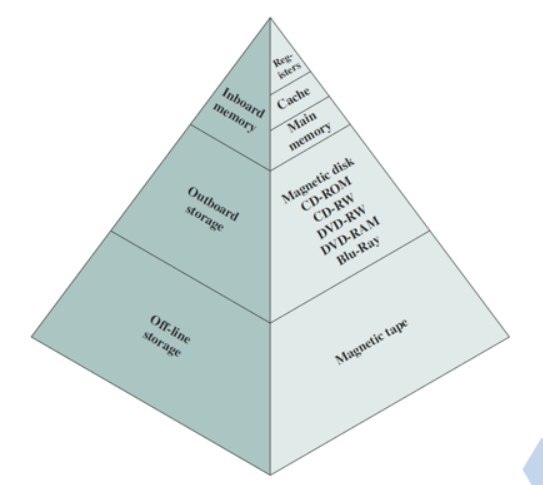
Capacity
- Word size
- Internal memory: in words or bytes. 8bit, 16bit,32bit;
- External memory: in bytes
- Number of words
- How many words or Bytes
Unit of Transfer
- Internal
- Usually governed by data bus width
- External
- Usually a block which is much larger than a word
- Addressable unit (可寻址单元)
- Smallest location which can be uniquely addressed
- Normally, it is word
- Allowing byte
- Address length & addressable unit: N = 2 A N=2^A N=2A
Access Methods
-
Sequential
- Start at the beginning and read through in order
- Access time depends on location of data and previous location
- e.g. tape
-
Direct
-
Individual blocks have unique address
-
Access is by jumping to vicinity plus sequential search
-
Access time depends on location and previous location
为啥需要看上次的位置
-
e.g. disk, optic disk
-
-
Random: address-based access
- Individual addresses identify locations exactly
- Access time is independent of location or previous access
- e.g. DRAM
-
Associative(混合的): comparing part of content to access, a kind of random access
- Data is located by a comparison with contents of a portion of address for all the words
- Access time is independent of location or previous access
- e.g. cache
Performance Factors of Memory
-
Access time: the time of getting data out of memory. Different memory has different access time.
-
For random access memory, access time is from the instant the address presented to memory to the instant of the data on the bus.
对于随机存取存储器,存取时间从呈现给存储器的时刻到总线上数据的时刻 (什么意思?)
-
-
Memory cycle time: access time + additional time before a second access
- Used for random access memory
-
Transfer rate R: data transferred into or out of a memory unit per second
-
1/ Memory cycle (for random access memory)
-
T n = T a + ( N / R ) Tn=Ta+(N/R) Tn=Ta+(N/R)(for non-random access memory)
公式咋来的?
-
Physical Types (material)
- Semiconductor (LSI/VLSI)
- RAM, ROM
- Magnetic
- Disk & Tape, mobile hard-disk
- Optical
- CD & DVD
Physical Characteristics
- volatile/nonvolatile(易失)
- Erasable or not (ROM/EPROM)
- Power consumption
Memory Hierarchy
For memory,the questions we concern are:
- Capacity
- Velocity(速度)
- Price

Locality of Reference
Principle of locality of reference
during the course of program execution, CPU accesses instructions or data in cluster.
- Because:
- Programs typically contain many loops and subroutines – repeated references;
- Table and array involve access to clustered data set – repeated references
- Programs or data are always put in sequence, instructions or data to be accessed are typically nearby current instruction or data.
Two types of locality:
- Temporal locality: if an item is referenced, it will tend to be referenced again soon
- Spatial locality: if an item is referenced, items whose addresses are close by tend to be referenced soon
Cache memory principles
Cache
- Small amount of fast memory
- Sits between normal main memory and CPU
- May be located on CPU chip or module
- Cache contains copies of sections of main memory
- Operates at or near the speed of the processor

- Main memory contains
2
n
2^n
2n words/units,K words consist of a block
- Total blocks: $ M=\frac{2^n}{K}$
- Cache contains C lines, a line contains K memory words
- A cache line = a memory block
- C<<M
- At any time, at most C blocks can reside in the Cache
- A line can not be occupied by a fixed block
- Each line has a tag to identify which block of memory
- Many memory blocks can mapped into a cache line

Cache operation
- Part contents of main memory are also in Cache
- CPU requests contents of memory location
- Check cache for this data
- If present, get from cache (fast)
- If not present, read required block from main memory to cache
- And deliver the word to CPU
- Cache includes tags to identify which block of main memory is in each cache slot
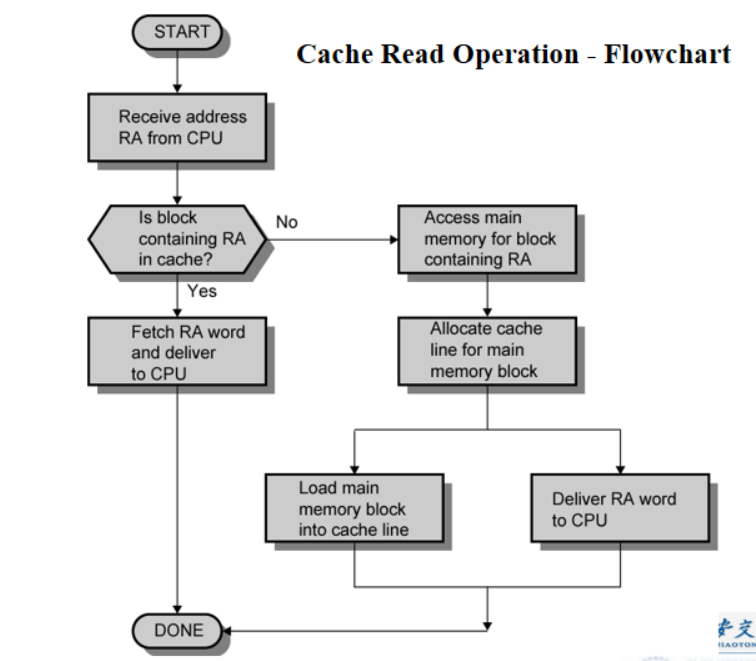
Typical Cache Organization

Cache Design
Key Techniques in Cache Design
- Size
- Mapping Function
- Replacement Algorithm
- Write Policy
- Block Size
- Number of Caches
- Address of Cache
Size
- Small size
- Cheap: Cache-Memory price is close to the price of main memory
- Low hit, access speed may be slower than accessing main memory
- Large size
- High hit: close to 100%, access speed may be close to Cache access
- costly
- More Gates, slightly slower than small cache
- Large CPU area occupation
- Trade-off between capacity, price and speed
- No optimum cache size, 1K~512K words are all effective
Mapping function
- Mapping mechanism needed
- Mapping memory block to cache line
- Which memory block occupies which cache line
- Mapping function is implemented in hardware
- Mapping function determines cache structure
- Typical mapping functions:
- Direct Mapping
- Associative Mapping
- Set Associative Mapping
假设
- Cache大小是64KB
- 每个块包含4个字,每个字1B,因此Cache一共 16 K = 2 14 16K=2^{14} 16K=214行
- 主存的大小是16MB,根据字索引,因此一共有 4 M = 2 22 4M=2^{22} 4M=222个块
Direct Mapping
The simplest mapping, block to fixed line
Each main memory block is assigned to a specific line in the cache: i = j m o d m i = j\ mod\ m i=j mod m

映射到缓存中同一行的块块号低地址相同

Direct Mapping Implement
memory address separated into 3 parts:
- Low w bits identify content/word
- Middle r bits identify Cache line
- Left bits identify whether the data is needed — Tag identify which memory block

Direct Mapping Cache Organization
查找方式:首先根据Line查找Cache中对应的行,然后检查该行的Tag与字地址中的Tag是否相同
- 如果相同,则根据字地址中的Word查找该行中对应的字即为所需要的数据
- 如果不同,则说明缓存中没有该数据所在的块,因此应该根据Tag+Line组成块号去内存中超找到对应的块,然后根据Word找到对应的字,同时将整个块放入Cache对应的行中
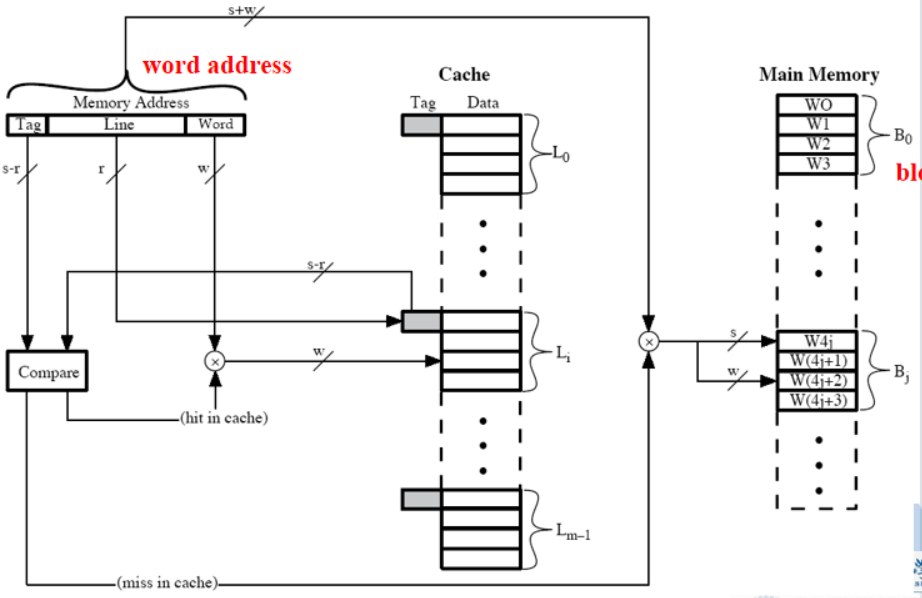
Direct Mapping Summary
s:Tag+Line w:Word
- Address length = (s + w) bits
- Number of addressable units = 2s+w words or bytes
- Block size = line size = 2wwords or bytes
- Number of blocks in main memory = 2s+w/2w = 2s
- Number of lines in cache = m = 2r
- Size of tag = (s – r) bits
Direct Mapping pros & cons
- Simple
- Inexpensive to implement
- Fixed location for given block
- If a program accesses 2 blocks that map to the same line repeatedly, cache misses are very high —thrashing
Fully Associative Mapping
- A main memory block can load into any line of cache
- Block and line have no fixed mapping relationship
- Memory address = tag + word
- Tag uniquely identifies block of memory
- Every line’s tag is examined for a match
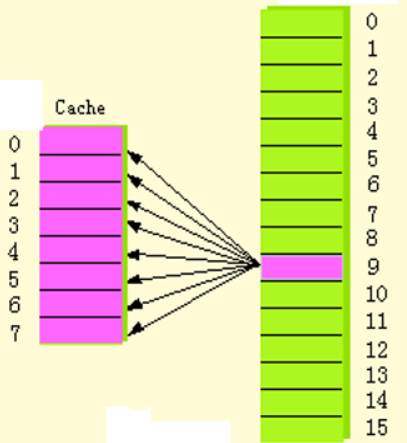
Fully Associative Implement
memory address separated into 2 parts:
-
Low w bits identify content/word
-
left r bits identify the Cache Tag

Fully Associative Cache Organization
查找方式:根据字地址的Tag与缓存中每行的Tag一一对比
- 如果找到,则根据Word找到行中对应的字
- 如果没找到,则根据字地址的Tag去内存中找到对应的块,然后根据Word找到对应的字,同时根据替换算法将该块放入Cache中合适的行中

Associative Mapping Summary
s:Tag+Line w:Word
- Address length = (s + w) bits
- Number of addressable units = 2s+w words or bytes
- Block size = line size = 2w words or bytes
- Number of blocks in main memory = 2s+w/2w = 2s
- Number of lines in cache = undetermined
- Size of tag = s bits
Fully Associative Mapping pros & cons
- pros:
- A memory block can be mapped into any line of the cache
- Replacing is flexible
- cons :
- Parallel comparing circuit is needed
- Complex and expensive
Set Associative Mapping
- Divide cache and memory into sets, each set includes lots of lines.
- Direct mapping for cache set and memory set
- Full associative mapping between two sets
- Set associative mapping=direct mapping + Full associative mapping
- A cache of m lines is divided into v sets, k lines/set, then
- m = v × k m=v\ \times\ k m=v × k
- Set number of Cache i = block number of memory mod v
- A given block may map to any line in a given set
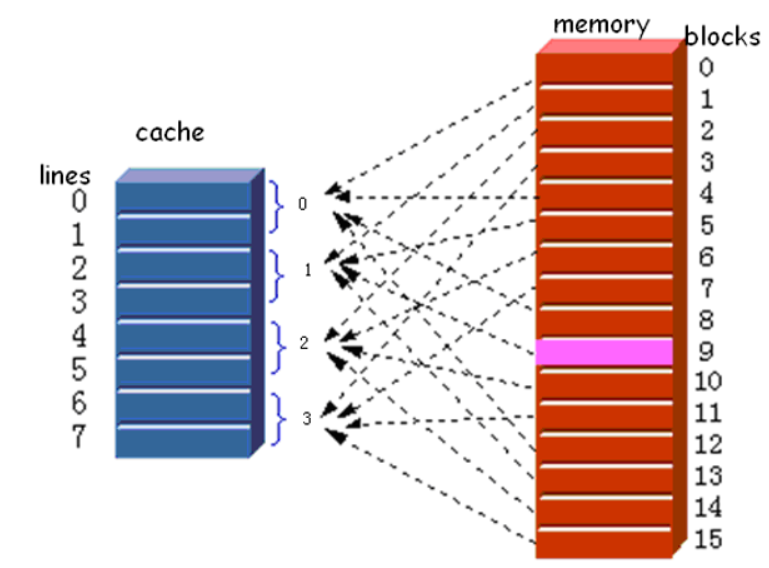
K Way Set Associative Implement
memory address separated into 3 parts:
- Low w bits identify content/word
- Middle r bits identify Cache Sets
- Left bits identify whether the data is needed — Tag identify which memory block

K Way Set Associative Cache Organization
查找方式:首先根据Set查找Cache中对应的组,然后查找该组中是否有和字地址的Tag相同的行
- 如果有,则根据字地址中的Word查找该行中对应的字即为所需要的数据
- 如果没有,则说明缓存中没有该数据所在的块,因此应该根据Tag+Set组成块号去内存中找到对应的块,然后根据Word找到对应的字,同时将整个块放入Cache对应的行中

Set Associative Mapping Summary
- Address length = (s + w) bits
- Number of addressable units = 2s+w words or bytes
- Block size = line size = 2w words or bytes
- Number of blocks in main memory = 2s
- Number of lines in set = k
- Number of sets = v = 2d
- Number of lines in cache = kv = k x 2d
- Size of tag = (s – d) bits
Summary
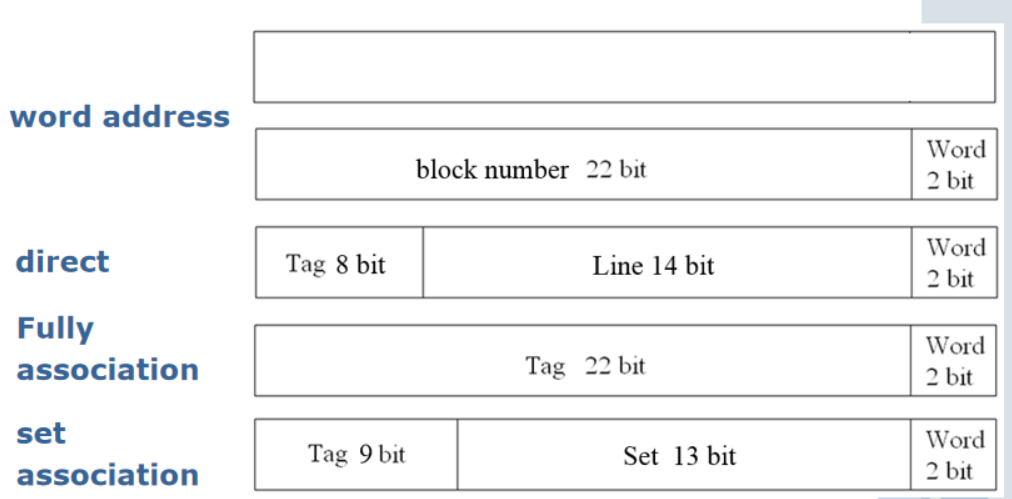
Replacement Algorithms
Direct mapping
- No choice
- Each block only maps to one line(fixed)
- Replace that line
Associative & Set Associative
- Hardware implemented algorithm (speed)
- Least Recently used (LRU):use=1/0 as mark bit
- e.g. in 2 way set associative
- Which of the 2 block is LRU?
- e.g. in 2 way set associative
- First in first out (FIFO)
- replace block that has been in cache longest
- Least frequently used
- replace block which has had fewest hits
- Random :performance is almost the same as LRU
- Optimized :replace the line accessing in the farthest future

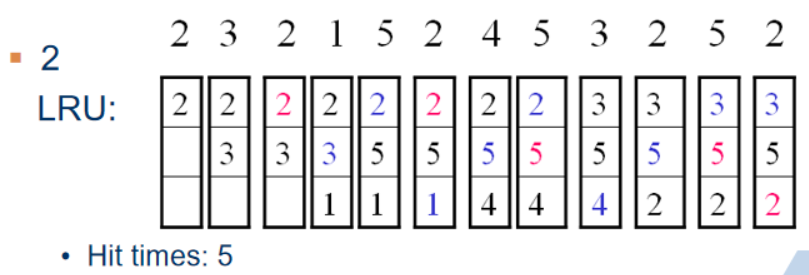

Write Policies
- Different from read, Cache write is more complex
- Data consistency between Cache, Memory and other Caches
- Two Cache write policies used usually for single CPU system:
- Write through (写直达)
- Write back (写回)
Write through
- Def.: write memory while writing Cache(缓存和内存一起写)
- All writes go to main memory as well as cache
- disadvantages:
- Lots of writing traffic,may result in bus bottleneck
- Slows down writes
Write back
- Write back :not only write Cache, but also modified flag is put in the written line, and when the line is replaced, write back that line to memory
- Updates initially made in cache only 只在cache更新数据
- Update bit for cache slot is set when update occurs
- If block is to be replaced, write to main memory only if update bit is set
- Suitable for iterative operation and the system that I/O module is directly connected to Cache
- disadvantages:
- Part of contents in the memory is invalid
- Circuit is complex
- Cache may become bottleneck
multiple CPU
- Bus watching with write through
- Cache controller monitors address lines, if a location is written in the shared memory and the data is in the cache, invalidate the cache entry.
- Hard Transparency
- Additional hardware is used . When a cache writes memory, corresponding entry in other caches is also updated
- Noncachable Memory
- Many CPU share a potion of main memory, shared contents are never copied into caches
不太明白都是啥,忘了
Cache line size vs. hit rate
- Principle of locality : the data in the vicinity of referenced word are likely used in the near future
- Block transferred
- To some extent, increasing line size will result in hit rate increase
- But, if the line is too large, hit ratio will become decrease
- Replace by a line
- Probability using new data is less than that of using replaced data
- Line size vs hit ratio is decided by local characteristic of program.
- No optimum
Number of Caches
- Single cache vs multilevel Cache
- On-chip Cache(L1):short path to CPU, fast speed and reduce the frequency of bus access
- Off-chip Cache(L2):only L1 access miss results in accessing L2
- Unified Cache and Split Cache
- Unified Cache(统一缓存,同时存储指令和数据):
- Storing Data & instruction, balancing load automatically
- Hit rate high
- Split Cache(分开存储指令和数据):
- Data Cache & instruction Cache
- Parallel operation
- Unified Cache(统一缓存,同时存储指令和数据):
Vocabulary
- DRAM(Dynamic random-access memory):动态随机存取(访问)存储器
- ZIP Cartridge: ZIP活动磁盘
- Controller:控制器
- Capacity:容量
- Unit of transfer:传送单元
- Addressable unit:可寻址单元
- Sequential access:顺序访问
- Associative access: 关联访问
- Nonvolatile memory:恒态存储器
- WORM(write once read many):一写多读存储器
- MO(magneto-optical disk):磁光盘
- Set associative mapping:组关联映射
- Replacement Algorithm:替换算法
- FIFO(first-in- first- out):先进先出
- LRU(least frequently used):最近最少使用
- Write through:写直达
- Retire unit:回收单元
- Consistency:一致性
- Coherency:一致性
Key points
- How about Memory Hierarchy? What executes it according to?
- Where can block be placed in cache?
- How is block found in cache?
- Which block is replaced on miss in cache?
- How about writes policy in cache?























 558
558











 被折叠的 条评论
为什么被折叠?
被折叠的 条评论
为什么被折叠?










